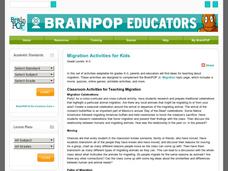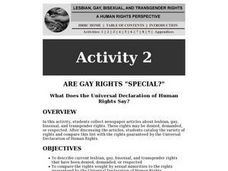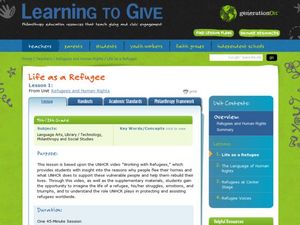BrainPOP
Migration Activities for Kids
For as long as there has been life on earth, animals, including humans, have used migration as a means of survival. This collection of activities supports young scientists as they learn about this behavioral adaptation, encouraging them...
Curated OER
The Ugly Duckling: A Discussion of Human Rights
Young scholars, after listening to The Ugly Duckling, by Hans Christian Anderson, become more aware of their relationship to human rights in regards to equality, justice, fairness, civil rights, and social justice.
Curated OER
The Human Heart
Third graders explore the human heart and the circulatory system. They observe how exercise affects the heart rate and how blood vessels carry blood through the heart and body. Students observe how the blood is carried to and from the...
Federal Reserve Bank
Lesson 4: Back to School
Based on your current level of human capital, how long would it take you to earn $1,000,000? What about your potential human capital? Learners explore the importance of education and experience when entering the workforce, and compare...
Curated OER
Growing Up
Help little learners understand what happens during the human life cycle. Each slide defines and poses discussion questions regarding each phase of human life. Infancy, childhood, the teen years, adulthood, and old age are all covered....
Curated OER
Are Gay Rights "Special"?
Inspire critical thinking with this activity, which prompts students to compare lesbian, gat, bisexual, and transgender rights with the rights guaranteed by the Universal Declaration of Human Rights. By collecting topical articles about...
Curated OER
AP: Chapter 20: DNA Technology
This nine-page biotechnology resource contains six pages of questions regarding DNA technology. Questions cover cloning, restriction enzymes, the polymerase chain reaction, different techniques, the human genome project, and more. The...
Curated OER
The Circulatory System
Tell the class to feel their heart beating because it's time to talk about the circulatory system! Presented here is a series of explanatory slides that provide a simple, yet accurate depiction of the human cardio-vascular system. All...
Federal Reserve Bank
Journey to Jo’burg: A South African Story
How did South African apartheid affect the ability of people of color to increase their human capital? Here is a rich lesson in which learners come to understand the relationship between investment in human capital and income, while also...
Curated OER
Life as a Refugee
Lesson 1 from a Refugees and Human Rights unit is based on the UNHCR video “Working with Refugees.” Pupils gain an understanding of the role the United Nations plays in protecting and assisting refugees worldwide and have an opportunity...
Curated OER
Bones Provide Great Support!
How do bones help people move around? A science investigation prompts kids to draw arrows to certain bones that protect their organs. After they finish, they trace their hands on a piece of paper and trace the way their bones go. Great...
Curated OER
You've Got to Have Heart
After reading an excellent description of the human heart, fifth graders look at a drawing of a human body, and choose the circle they think represents where the human heart is found. There are four circles inside the character's chest....
Curated OER
My Body
First Graders practice using the names of body parts by finding pictures and placing them in the correct position on a life-size outline of a human body. These type of hands-on lessons are one of the best ways for young learners to truly...
Curated OER
How Are Stars Like People?
A beautifully written lesson plan delves into a beautiful topic: stellar population. Engage aspiring astronomers with activities that examine human populations and then transition onto the stars of the universe. Data and photographs for...
Curated OER
Raven Chapter 24 Guided Notes: Evolution of Genomes and Developmental Mechanisms
Explore the evolution of genomes and the human DNA sequence by answering 10 questions on this worksheet. The level of questions included will challenge your advanced biology class to a deeper understanding of genomics.
Curated OER
Understanding the Body, Day 1: Anatomy
Intended for moderate to severely disabled students, this lesson focuses on building an understanding of human anatomy. A secondary special education class reviews, identifies, and labels parts of the body. Including the internal and...
EngageNY
Building Background Knowledge: Why Do Workers Strike? (Chapter 11: "Los Aguacates/Avocados")
Make connections between Esperanza Rising and human rights with the activities outlined here. The instructional activity starts out with a brief quiz and review of the novel. After that, pupils circulate and share quote strips that you...
National Geographic
Genetic Markers: Connecting the Dots
Biology buffs simulate how genetic markers are passed among populations in order to understand how these markers can help anthropologists map human migration. A couple of volunteers leave the room while you walk the remaining learners...
Federal Reserve Bank
Investing in Yourself: An Economic Approach to Education Decisions
What is the difference between physical capital and human capital, and in which should you invest? While considering the concept of return on investment, take a look at the payoffs and consequences of investing in training and...
University of California
Migration of Early Humans: Evidence and Interpretations
While much of prehistory is cloaked in mystery, ancient ancestors left evidence in DNA, languages, and materials from their time. Using photographs of items such as cave paintings and ancient tools, as well as maps of linguistic patterns...
Curated OER
Be Kind to Your Teeth
What kinds of food can be bad for your teeth? Kindergartners and first graders explore dental health with an interactive science inquiry. Given a choice of foods such as celery, cake, and milk, kids choose which ones are better for their...
Curated OER
Writing Exercises: World War I, #3
What does your class know about WWI? They can share their knowledge by responding to three short-answer questions. They'll discuss human rights issues during WWI, the role of imperialism, and causes of the war from the perspective of the...
US National Archives
Documented Rights Educational Lesson Plan
How have groups struggled to have their unalienable rights recognized in the United States? Acting as a research team for the Human Rights Council of the United Nations, your young historians will break into groups to research...
Curated OER
Getting nosy
A nose knows! Connect animals to their noses with a fun science activity. Animals include elephants, rats, pigs, and even humans. For a science exploration, kindergartners answer questions about what they can smell. A great addition to...
Other popular searches
- Arts and Humanities
- Humanities and Music
- Humanities and Culture
- Art and Humanities
- Integrated Humanities
- What Are the Humanities
- Humanities Ancient Greece
- Humanities Africa
- Arts Humanities
- Arts; Humanities
- Primary Humanities
- Humanities Morality Plays























